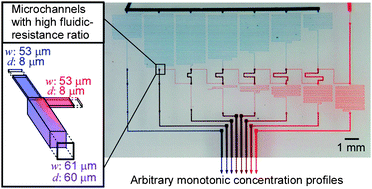This paper reports a serial dilution microfluidic network composed of microchannels with a high fluidic-resistance ratio for generating linear concentration profiles as well as logarithmic concentration profiles spanning 3 and 6 orders of magnitude. The microfluidic networks were composed of thin fluidic-resistance microchannels with 160 to 730 µm2 cross-sectional areas and thick diffusion-mixing microchannels with 3,600 to 17,000 µm2 cross-sectional areas, and were fabricated from polydimethylsiloxane by multilayer photolithography and replica molding. We proposed a design algorithm of the microfluidic network for an arbitrary monotonic concentration profile by means of a hydrodynamic calculation. Because of the high fluidic-resistance ratio of the fluidic-resistance microchannels to the diffusion-mixing microchannels, appropriate geometry and dimensions of the fluidic-resistance microchannels allowed us to obtain desired concentration profiles. The fabricated microfluidic network was compact, occupying a 8 × 18 to 21.0 × 13.5 mm2 area on the microchip. Both the linear and the logarithmic concentration profiles were successfully generated with the error less than 15% for the linear concentration profile, 22% and 35% for the logarithmic concentration profiles of 3 and 6 orders of magnitude, respectively. The generated linear concentration profiles of the small molecule, calcein, were independent of the flow rate within the range of 0.009 to 0.23 µL/min. The concentration profiles of the large molecules, dextrans, depended on the flow rate and molecular weight. The required residence time of large molecules in the diffusion-mixing microchannel was correlated with dimensionless diffusion time, Fick number, and was discussed based on the scaling law. These compact, stable serial dilution microfluidic networks are expected to be applied to various integrated on-chip analyses.

You have access to this article
 Please wait while we load your content...
Something went wrong. Try again?
Please wait while we load your content...
Something went wrong. Try again?


 Please wait while we load your content...
Please wait while we load your content...